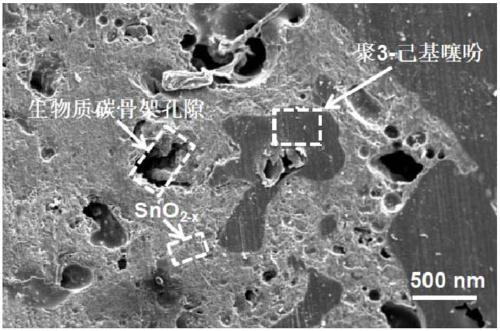Preparation method of poly-3-hexylthiophene/biomass carbon/SnO2-x nano-composite photocatalytic material
A technology of photocatalytic materials and biomass carbon, applied in the direction of organic compound/hydride/coordination complex catalysts, chemical instruments and methods, physical/chemical process catalysts, etc., can solve the problem of obvious material agglomeration effect and insufficient reaction raw materials , cumbersome steps and other problems, to achieve the effect of simple and efficient process, overcome the mismatch of energy level structure and low preparation temperature
- Summary
- Abstract
- Description
- Claims
- Application Information
AI Technical Summary
Problems solved by technology
Method used
Image
Examples
Embodiment 1
[0032] 1) Heat the biomass waste coconut shell from room temperature to 100 °C for 10 hours at a heating rate of 2 °C / min in a nitrogen atmosphere, and cool to room temperature after the reaction to obtain a biomass carbon skeleton;
[0033] 2) get 1mmol analytically pure stannous tartrate (C 4 h 4 o 6 Sn) and 0.2mmol of tartaric acid (C 4 h 6 o 6 ) was fully dissolved in 5 mL of absolute ethanol, and then 2 mmol of dodecyl ethoxy sulfobetaine and 10 mL of deionized water were added successively. The magnetic stirring device continuously magnetically stirs it at a temperature of -20°C until it is completely dissolved to obtain solution A;
[0034] 3) Take 0.5g of the ground biomass carbon skeleton and add it to solution A, and use a constant temperature magnetic stirring device to carry out continuous stirring at -20°C during the whole process in an ice-salt bath of sodium chloride and crushed ice. Stir magnetically until the mixture is evenly mixed to obtain the mixed s...
Embodiment 2
[0039] 1) Under an argon atmosphere, the biomass waste leaves were heated from room temperature to 180 °C at a heating rate of 7 °C / min and kept for 6 hours, and the reaction was completed and cooled to room temperature to obtain a biomass carbon skeleton;
[0040] 2) get 1mmol analytically pure stannous tartrate (C 4 h 4 o 6 Sn) and 2mmol of tartaric acid (C 4 h 6 o 6) was fully dissolved in 9mL of absolute ethanol, then 8mmol of dodecyl ethoxy sulfobetaine and 15mL of deionized water were added successively, and the whole process was carried out at a constant temperature in an ice-salt bath of sodium chloride and crushed ice. The magnetic stirring device continuously magnetically stirs it at the temperature of -15°C until it is completely dissolved to obtain solution A;
[0041] 3) Take 2g of the ground biomass carbon skeleton and add it to solution A. During the whole process, use a constant temperature magnetic stirring device to perform continuous magnetic force on i...
Embodiment 3
[0047] 1) Under a nitrogen atmosphere, the fallen leaves of the biomass waste were heated from room temperature to 300 °C at a heating rate of 8 °C / min and kept for 1 hour, and the reaction was completed and cooled to room temperature to obtain a biomass carbon skeleton;
[0048] 2) get 1mmol analytically pure stannous tartrate (C 4 h 4 o 6 Sn) and 2.8mmol of tartaric acid (C 4 h 6 o 6 ) was fully dissolved in 15mL of absolute ethanol, then 12mmol of dodecylethoxy sulfobetaine and 20mL of deionized water were added successively, and the whole process was kept at constant temperature in an ice-salt bath of sodium chloride and crushed ice. The magnetic stirring device continuously magnetically stirs it at a temperature of -10°C until it is completely dissolved to obtain solution A;
[0049] 3) Take 6g of the ground biomass carbon skeleton and add it to solution A. During the whole process, use a constant temperature magnetic stirring device to perform continuous magnetic fo...
PUM
 Login to View More
Login to View More Abstract
Description
Claims
Application Information
 Login to View More
Login to View More - R&D
- Intellectual Property
- Life Sciences
- Materials
- Tech Scout
- Unparalleled Data Quality
- Higher Quality Content
- 60% Fewer Hallucinations
Browse by: Latest US Patents, China's latest patents, Technical Efficacy Thesaurus, Application Domain, Technology Topic, Popular Technical Reports.
© 2025 PatSnap. All rights reserved.Legal|Privacy policy|Modern Slavery Act Transparency Statement|Sitemap|About US| Contact US: help@patsnap.com

